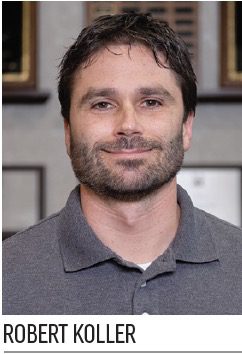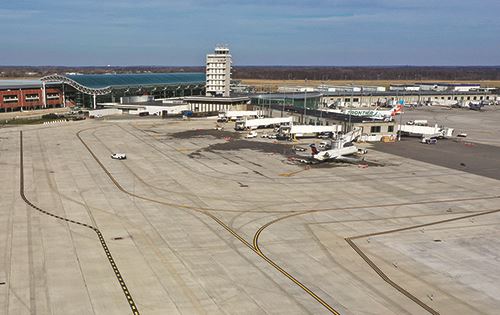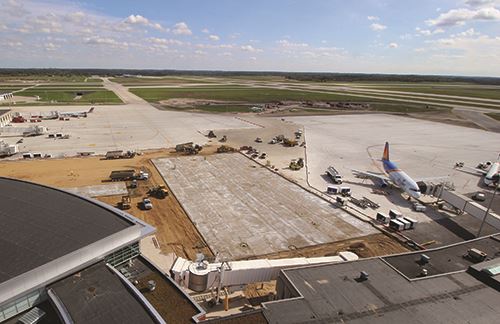Earlier this year, contractors finished the final punch list for a much needed $50 million apron reconstruction and expansion project at Gerald R. Ford International (GRR) in Grand Rapids, MI. Casey Ries, engineering and planning director at GRR, was glad to close out the complex project the airport began planning back in 2015. Ries explains that 2018 to 2019 was the ideal time to reconstruct the terminal apron because the physical condition of the pavement was not great and the logistic conditions were favorable
Earlier this year, contractors finished the final punch list for a much needed $50 million apron reconstruction and expansion project at Gerald R. Ford International (GRR) in Grand Rapids, MI.
 Casey Ries, engineering and planning director at GRR, was glad to close out the complex project the airport began planning back in 2015. Ries explains that 2018 to 2019 was the ideal time to reconstruct the terminal apron because the physical condition of the pavement was not great and the logistic conditions were favorable—funding was secured, traffic was growing and the rest of the airfield had been recently improved. In fact, in the midst of reconstruction, traffic grew so swiftly that it helped officials secure approval and funding to expand the apron as well.
Casey Ries, engineering and planning director at GRR, was glad to close out the complex project the airport began planning back in 2015. Ries explains that 2018 to 2019 was the ideal time to reconstruct the terminal apron because the physical condition of the pavement was not great and the logistic conditions were favorable—funding was secured, traffic was growing and the rest of the airfield had been recently improved. In fact, in the midst of reconstruction, traffic grew so swiftly that it helped officials secure approval and funding to expand the apron as well.
Ries notes that the existing pavement had been built piece by piece over the years, and included eight sections with different specifications, thicknesses, ages and overall conditions. So the airport relished the opportunity to improve the apron around all of Concourse A and the southern half of Concourse B in a holistic manner.
|
facts&figures
Project: Apron Reconstruction Location: Gerald R. Ford Int’l Airport—Grand Rapids, MI Total Cost: $50 million
Reconstruction Funding: 90% Airport Improvement Program, 5%
Scope of Reconstruction: Scope of Expansion: 48,000 sq. yards of 16-inch pavement Secondary Elements: New LED lighting; roughly 16 miles of apron markings (temporary & permanent); 6.5 miles of underground storm drainage Designer: C&S Companies
General Contractor: Kamminga Aircraft Parking Design: CAGE Glycol Recovery System Design: Gresham Smith Glycol Recovery System Controls: West Michigan Controls
Interlocking Safety Barricades:
Traffic Management Software:
Reconstruction Design:
Reconstruction Construction: Expansion Design: 2018-2019
Expansion Construction: Recognitions: 2020 Michigan Concrete Paving Assn. Award of Excellence (apron reconstruction); 2021 ACEC Michigan Engineering Merit Award (apron reconstruction & expansion); 2021 ASCE Michigan Outstanding Civil Engineering Achievement Merit Award (apron reconstruction & expansion) |
With the rest of the airfield posting pavement condition index scores greater than 85 and with airfield capacity needs being met, GRR kicked off apron reconstruction in 2018. “Our runways were in great shape, taxiways had been expanded and brought to current standards,” Ries recalls. “It was time to address the terminal apron.”
Assembling a Team
Project designer C&S Companies was involved very early in the planning process, even before the airport had secured funding. “The team approach to the project was critical,” Ries explains. After assembling the design team via a qualification-based selection in early 2015, GRR quickly engaged its airline partners, knowing that phasing would be critical to project success.
Project contractor Kamminga & Roodvoets of Grand Rapids successfully won the bid in November 2017 and rounded out the project team.
The $32 million reconstruction project covered about 167,000 square yards of apron pavement, and FAA Airport Improvement Program funds paid for 90% of the cost. Work spanned two construction seasons (April through October in West Michigan), and planners phased the project so that no more than two jet bridges or one of the three connector taxiways to the apron was closed at the same time.
Beyond the baseline phasing provisos, GRR’s airline partners naturally were interested in how the project would affect their day-to-day operations. More specifically, they analyzed how aircraft, personnel and baggage tugs would navigate the construction.
Ries emphasized the importance of coordinating the apron work with airport operations, airport police and security, and the airport rescue and firefighting team. “Every time we made a change to operations, response routes and pathways would change,” he notes. “It worked because the team committed to communicating and meeting so regularly.”
Plans had to remain fluid and flexible, because when phasing was established, aircraft movement numbers were fully 20% less than what GRR ultimately experienced in 2019 as the project came to a close. Planning was based on GRR’s primarily ADG II fleet mix of 2015 and 2016, but the type and frequency of aircraft operating there grew larger over the intervening years with significant ADG III operations in 2019.
Early and constant coordination, along with a commitment to engaging all impacted parties, contributed to the success of the project, says Ries.
 The biggest challenge for project manager Robert Koller, a service group manager at C&S Companies, was developing a phasing plan that would not negatively impact airline operations. Stakeholder outreach included continual meetings with airlines, tenants and the airport, and implementing a plan that would work for all parties.
The biggest challenge for project manager Robert Koller, a service group manager at C&S Companies, was developing a phasing plan that would not negatively impact airline operations. Stakeholder outreach included continual meetings with airlines, tenants and the airport, and implementing a plan that would work for all parties.
Ries notes that C&S used various tech-based construction management systems to keep the construction team, designers, airport personnel and tenants fully engaged with digital documentation, daily reporting, record drawings and photo management.
Greg Fehrman, principal engineer and lead onsite resident project representative with C&S, agrees that the projects benefited from a 100% electronic construction management system. “The only real paper utilized was the sign-in sheets for the meetings the first two years,” he recalls. “The third year, there wasn’t even a sign-in sheet because everything was done remotely [due to COVID-19].”
Digital reports were sent out weekly to detail progress, and schedule updates were issued every other day to prevent the highly fluid project from impacting operations. “The contractor really bought in and adapted to it, so it worked seamlessly the whole way,” Fehrman says of the electronic management approach.
 Specific cloud-based tech tools included InfoTech’s Appia for project management, DocExpress for document management and SmartVid for photo management. “We were very transparent,” Fehrman relates. “Anybody who wanted access could get to it—just in the project management, it was read-only access. We had nothing to hide, and we really headed off potential snags by being that transparent.”
Specific cloud-based tech tools included InfoTech’s Appia for project management, DocExpress for document management and SmartVid for photo management. “We were very transparent,” Fehrman relates. “Anybody who wanted access could get to it—just in the project management, it was read-only access. We had nothing to hide, and we really headed off potential snags by being that transparent.”
Phasing Was Critical
The apron reconstruction project was subdivided into seven phases. This limited impact to operations, but did not leave much room for contractors to work in some areas, Koller notes. Temporary provisions were created for aircraft taxiing and parking while areas were closed for construction, and some gates were consequently restricted to smaller aircraft due to limited room. “It was a lot of coordination, both in the design and construction,” Koller reflects.
As airlines moved gate positions, information technology systems had to be moved accordingly. Scheduling such work with airline and airport IT departments in concert with construction took careful planning to ensure that contractors were hitting schedules, while also remaining flexible. “It was a lot of temporary planning for each of those phases,” he explains. “Whether it was construction access, aircraft parking or temporary pavement ramps for aircraft between the phases, there was a lot of temporary work that had to be done just to go from phase to phase.”
Timing of the phases was primarily dictated by airline operations and construction access because thousands of trucks and personnel needed access to the most secure areas of the airport. “How they accessed and where they crossed active taxiways was a very big deal,” Ries remarks. “We didn’t want to travel over completed portions of pavement any more than we needed. So it was operations, safety and security all top of mind first.”
It was essential to clearly define contractor areas and aircraft operating areas, he adds. Contractor access points and haul routes were all specific and dedicated to those activities. When haul routes needed to cross active taxiways, the project team used dedicated flaggers outside of the taxiway object free area. To eliminate the need for engagement with air traffic control, contractor movements were kept to the non-aircraft-movement side of the airfield. Flaggers, however, monitored the ground control frequency to ensure safety. “By dedicating all those movement corridors for the contractor, they were able to isolate and control movements, and air traffic control had confidence that those potential conflicts were isolated and controlled,” Ries explains.
All contractors working on the site had to be vetted, trained and issued security badges. The project also included fulltime vacuum trucks on all haul routes to control foreign object debris. On active movement areas of the apron, low-profile barricades were used to delineate work areas.
Ries notes that it was imperative to consider all vehicle movement on the airfield during and after construction. Subconsultant CAGE used PathPlanner software to evaluate temporary and final apron markings to manage the movement of aircraft tugs, contractor equipment and other vehicles. For Ries, the interim markings were just as important as those that became permanent because the temporary markings helped keep contractors and aircraft operators safe during construction.
In all, crews applied about 16 miles of pavement markings. With six airlines operating at GRR throughout the project, the process required coordinating with each carrier for its specific gate marking standards. When the project was complete, 14 of the airport’s 15 gates were preferentially leased, with just one open for common use.

Expansion Adds Challenges
During apron reconstruction, traffic at GRR was growing quickly—so quickly that by the end of 2019, the airport was seven years ahead of FAA forecasts from only three years earlier. “Incredible things were happening in our region,” explains Ries. “Businesses were diversifying in West Michigan, and that tremendous growth was reflected at the airport.”
Fehrman notes that significant increases in operations led to “quite a bit of juggling” and a tremendous amount of temporary markings. In addition to more aircraft moving in and out of the airport, the fleet mix also changed during the project, which required even more flexibility for planning and phasing.
“It was a full team effort, and we all had to adapt, adjust on the fly and accommodate changes that were inevitable,” Koller remarks.
Also during the project, Allegiant Air designated GRR as a maintenance base. This increased the number of aircraft based in West Michigan—and the associated need for overnight parking. New demand for eight remote remain overnight spaces introduced a challenge that Ries notes could not have been predicted during the project design phase. “Challenges and opportunities were stacking one on top of each other,” he recalls. “But continual engagement with airlines and the design and construction team made it work, and there wasn’t a single aircraft delay.”
In response to the rapid traffic growth, midway through the reconstruction project, GRR officials successfully documented the need to expand the apron and secured $14 million in FAA funding for an accelerated apron expansion project. While that was good news overall, the additional construction further complicated an already complex phasing process.
The expansion project required two construction seasons, beginning in 2019 and wrapping in 2020. As a result, the expansion project overlapped with the original reconstruction project in 2019, requiring even more careful coordination with stakeholders. Even though work was spread over two construction seasons, weather still posed some challenges.
“The apron expansion was necessary because of growth, but unexpected in 2019,” Ries reflects. From the airport’s perspective, it was fortunate that Kamminga & Roodvoets (the apron reconstruction contractor) was the successful low bidder for the expansion because that made it easier to dovetail the two projects cohesively.
Additional Improvements
In total, crews placed 215,000 square yards of new 16-inch pavement during the two projects. The project also upgraded overhead apron lighting to more energy-efficient LED fixtures and installed about 6.5 miles of underground storm drainage.
The reconstruction and expansion also allowed GRR to upgrade the apron to current National Fire Protection Association standards regarding drainage around where aircraft are fueled.
All told, about 200,000 cubic yards of soil was removed from the work area. Airport officials are especially proud that 99% of materials generated during the projects—including old concrete, piping and soil—was repurposed at GRR or elsewhere around the county.
Together, the recent apron improvements pave the way for Project Elevate, GRR’s capacity expansion project for Concourse A. The three-part program will include an eight-gate expansion and widening, construction of a Federal Inspection Station and relocating the air traffic control tower. Originally slated to break ground in April 2020, the Concourse A Expansion and Widening Project has been delayed due to the coronavirus pandemic.
|
Glycol Recovery During its recent apron reconstruction, Gerald R. Ford International (GRR) took the opportunity to expand its stormwater drainage system and install an automated underground glycol collection system. In lieu of a centralized deicing pad, the western Michigan airport uses most portions of the apron for aircraft deicing to support flexible airline operations. The airport had several goals in mind when planning the project: • improve the efficiency of capturing stormwater that contains deicers • reduce apron congestion from mobile collection units (its previous method of collecting deicing runoff) • reduce the staffing burden and operational costs of managing spent deicer • minimize environmental impact risk and, • if possible, maximize the volume of glycol that is recycled.
GRR’s new system for managing spent deicer includes: • reconfigured apron drainage to minimize the collection of stormwater from non-deicing areas and minimize the area where mobile collection units are needed; • routing drainage from the three drainage areas through individual pipes, and drawing stormwater samples from them every seven minutes; • reducing spikes in glycol concentration flow to the airport’s award-winning natural treatment system to maximize system performance; and • routing samples to independent online monitors (one for each apron) that measure total organic carbon concentrations, which are used as a surrogate for deicer and Biochemical Oxygen Demand concentrations. If Total Organic Carbon concentrations are high enough to allow economically efficient glycol recycling, stormwater from the drainage areas is routed to underground storage tanks. (The East Apron system has 105,000 gallons of storage; the West Apron system has 35,000 gallons of storage.) High concentration deicer is loaded from storage onto trucks for transport to a local glycol recycling and disposal facility. If total organic carbon concentrations are not high enough for economic recycling, the stormwater-deicer mix is routed to the airport’s natural biological treatment system. |


 Gresham Smith proposed an automated underground system that fulfilled all of GRR’s objectives. In addition, it requires less than half of the equipment and human power needed for mobile collection units, notes Tim Arendt, senior vice president at Gresham Smith.
Gresham Smith proposed an automated underground system that fulfilled all of GRR’s objectives. In addition, it requires less than half of the equipment and human power needed for mobile collection units, notes Tim Arendt, senior vice president at Gresham Smith.

